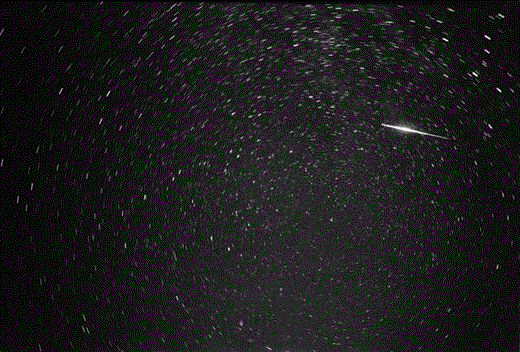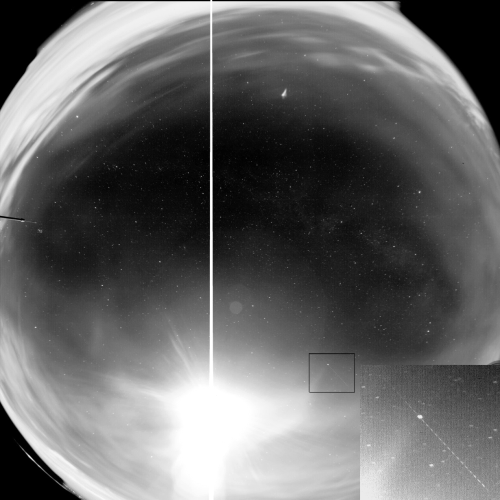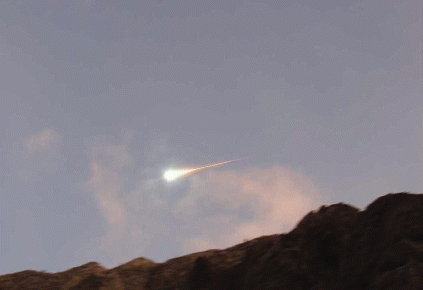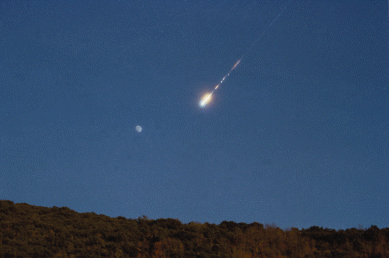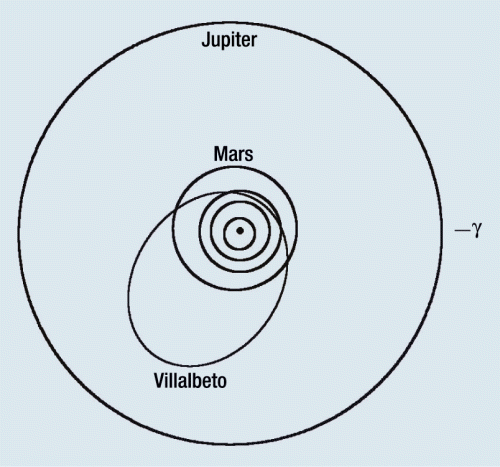-
PDF
- Split View
-
Views
-
Cite
Cite
Josep M Trigo-Rodríguez, Jordi Llorca, A J Castro-Tirado, J L Ortiz, J A Docobo, J Fabregat, The Spanish fireball network, Astronomy & Geophysics, Volume 47, Issue 6, December 2006, Pages 6.26–6.28, https://doi.org/10.1111/j.1468-4004.2006.47626.x
Close - Share Icon Share
Abstract
Josep M Trigo-Rodríguez, Jordi Llorca, Alberto J Castro-Tirado, José L Ortiz, José A Docobo and Juan Fabregat describe their interdisciplinary approach to minor bodies in the solar system.
The application of CCD and video cameras to meteor science has provided valuable information on the physico-chemical properties of meteoroids. The current status of the Spanish Fireball Network is described, focusing on the recovery of Villalbeto de la Peña. This L6 ordinary chondrite is the ninth solar system meteorite with a known orbit to be recovered. This meteorite came from the main belt of asteroids, but new delivery mechanisms have been identified.
The study of meteors and fireballs has grown over the past decade, as a consequence of the new optical and spectroscopic techniques developed for the Leonid meteor storms (Jenniskens and Butow 1999, Brown et al. 2002, Trigo-Rodríguez et al. 2004). These extraordinary events occur when the Earth crosses the dense dust trails left by comet 55P/Tempel-Tuttle. These encounters produce astonishing displays when thousands of millions of micron to centimetre-sized fragments (called meteoroids) enter the atmosphere, producing for a few hours meteor rates in the thousands (figure 1). Intensive scientific campaigns were promoted in order to study meteors and fireballs, emphasizing the physical processes that take place during the few seconds when large meteoroids interact with the Earth's atmosphere.
A -9 magnitude Perseid fireball imaged in double station on 12 August 1993 by our team. This 10-minute exposure was made under an extraordinarily dark sky in Peñarroya peak (Teruel, Spain). Polaris is near the centre.
When a meteoroid enters our atmosphere, continuous collisions with atmospheric components produce heating then melting and vaporization of its structure – a process called ablation. This process generates light, producing the luminous phase visible from Earth – a meteor. By recording meteors from different stations on the Earth's surface, it is possible to determine the atmospheric trajectories and height of the luminous phases. The progressive encounter with atmospheric layers of increasing density imposes dynamic stress on particles during deceleration that, in many cases, lead to fragmentation when the particle's tensile strength is exceeded. Consequently, accurate measurements of the height at which meteoroids fragment can provide information on the strength of individual particles and even the physical properties of their parent bodies (Trigo-Rodríguez and Llorca 2006). Meteor spectra can also provide valuable information on the meteoroids' chemical composition (Borovička 1993, Trigo-Rodríguez et al. 2003). These different lines of research allow us to learn about the various processes that take place during atmospheric interaction and also the role of meteors in the enrichment in organics and volatiles during the early stages of terrestrial evolution. Thus meteor science can provide important clues in an astrobiological context (Jenniskens et al. 2000).
Fireballs
Fireballs are particularly interesting events associated with the fragmentation of typically centimetre-sized particles that encounter the Earth at high velocities (typically in the range 11–72 km s-1). Beyond the showiness of a fireball, the study of the luminous path from several locations allows the determination of its atmospheric trajectory. When the entry velocity of a fireball can be determined, it is even possible to reconstruct its heliocentric orbit. Bright fireballs usually disintegrate in the terrestrial atmosphere after producing beautiful natural fireworks. However, more rarely, metre-sized bodies enter the atmosphere producing spectacular events that are called bolides. Bolides brighter than magnitude -17 are also detectable from space by defence satellites and are called superbolides. Sometimes fragments of the original body survive atmospheric interaction and reach the ground as meteorites, but only if the meteoroid trajectory, velocity and strength are propitious.
The SPanish Meteor Network (SPMN) is a research project studying meteor and fireball events in Spain. We made the first observational campaigns on several meteor showers during the 1990s, but the network itself was born in 1997. It is a joint venture between astrophysicists and chemists to collect as much information as possible on meteors and fireballs over Spain and bordering countries, but with special focus on the recovery of meteorites. Large fireballs announce meteorite falls and modern technology can track their atmospheric trajectories, from which we can estimate the fall location.
Meteorites are precious samples of solar system bodies, but usually are recovered without information on their solar system origin. Perhaps our fascination with meteorite research lies in the fact that it is one of the few fields of astronomy where researchers can hold in their hands extra-terrestrial samples from bodies that are studied remotely. The pioneer in this field was the Czech astronomer Znedek Ceplecha, who realized the value of this approach after the recovery of the Pribram meteorite in 1959 (Ceplecha 1961). Several fireball networks based on photographic cameras have been in operation since then, but the European Network (EN) located in Central Europe is the only one still operative. In 2002 members of our team developed the first all-sky high-resolution CCD camera, and we thought that the new instrument would be useful to extend meteor and fireball studies to our country. Several meteorite-dropping bolides have been recorded by our cameras since then, as we describe below. On 4 January 2004, using the previously created SPMN infrastructure, we got casual pictures and a video recording of a daylight fireball that produced the first recorded meteorite fall in Spain in 56 years. This meteorite recovery has become the largest SPMN scientific adventure so far.
Electronic eyes on the sky
Our all-sky CCD camera was developed in 2002 as part of the BOOTES-1 project to follow up gamma-ray bursts (GRBs) (Castro-Tirado et al. 1998) and was later applied to meteor and fireball detections (Trigo-Rodríguez et al. 2005). On 27 January 2003, just a couple of months after the first light for the prototype (BOOTES-1), we recorded the Nador superbolide more than 400 km away from the camera (Trigo-Rodríguez et al. 2003). We realized the extraordinary performance and potential of the prototype and have since developed new all-sky stations. During 2005 we started monitoring the sky from three or four locations, recording some extraordinary bolides (Trigo-Rodríguez et al. 2006b). Many fireballs have a random origin, but others – such as the Sigma Leonids – are associated with meteoroid streams (figure 2) that need to be studied in more detail. We are currently working on extra stations for the automated all-sky CCD network to be operative in 2006–2007 (figure 3).
A Perseid fireball (inside square) is seen near the Moon (magnified on the bottom right corner). We used a prototype with an inner shutter so that we can estimate the velocity and deceleration.
Some all-sky stations are located in remote places with excellent skies. This is the automated CCD camera of the Observatori Astronòmic de Montsec.
The sensitivity of the CCD all-sky system is exemplified by its ability to record magnitude +2/+3 meteors (Trigo-Rodríguez et al. 2005). The astrometric accuracy of the camera is ~1.5 arcmin, providing better resolution than many commercial video cameras, and close to the astrometric resolution of conventional photography on large-format EN cameras (Spurný and Borovička 2002). Despite this, we think it is time to study the capabilities of CCD cameras for meteor research, especially now that bigger CCD chips will soon provide more accurate cameras. The continuous monitoring of the sky that we are currently performing with these CCD cameras provides meteoroid spatial fluxes from annual meteor streams and will also give information on unexpected meteor activity produced when the Earth meets cometary dust trails.
Villalbeto de la Peña meteorite fall
Meteorite falls are announced by very bright bolides that are visible up to about 600 km away. In a few seconds typically metre-sized objects penetrate from outer space to the lower atmosphere at ultrasonic speeds. As a consequence, these events are sometimes audible. The superbolide that produced the Villalbeto de la Peña meteorite fall reached -18 absolute magnitude, intermediate between that of the full Moon and the Sun. This event was perfectly visible in the afternoon sky, and it is not strange that hundreds of eyewitnesses reported the fireball appearance to the SPMN. However, the most valuable data of this daylight bolide were obtained by chance in a video and three pictures taken by amateurs. Timing, location and weather conditions for this fireball were favourable, but many fireballs of identical luminosity pass unnoticed. For example, other meteorite-dropping daylight events that we are studying went completely unnoticed by people east of the trajectory because the bolide was too close to the glare of the Sun. However, some peculiarities of the Villalbeto de la Peña bolide were able to attract public attention.
The sonic boom produced by the meteoroid's fragmentation left windows and walls rattling and the ground shaking in the city of Guardo (Palencia), located practically below the meteoroid's trajectory. People out walking had an unforgettable view, a bluish ball crossing the sky (figure 4). The blast wave produced by the meteorite fragmentation at 28 km height was recorded at the seismic station of Arriondas (Asturias) operated by the Instituto Sismográfico Nacional, and was also detected by the Le Flers infrasound station located in France, more than ~750 km away. The fireball energy – from photometric, seismic, infrasound and dynamic data – was determined to be 0.02 kilotons (Llorca et al. 2005).
First picture of the Villalbeto de la Peña bolide taken from Las Oces de Valdeteja (León) by Salvador Díez.
A dusty train persisted for more than 30 minutes in the lower part of the bolide's trajectory and was photographed from several locations (figure 5), including Guardo. Some pictures were taken showing buildings or countryside features that were used for astrometric calibration (described in full detail by Borovička et al. 2003). The atmospheric trajectory and the velocity were determined from the meteoroid flight in the video frames and pictures. From the deduced velocity at the top of the atmosphere we obtained the ninth heliocentric orbit of a meteorite in the solar system (Trigo-Rodríguez et al. 2006). The orbit indicates its origin in the main asteroid belt (figure 6), just like in the eight previous cases of meteorites with well determined orbits. The study of cosmogenic noble gases produced an average cosmic-ray exposure age of 48±5 Ma (Llorca et al. 2005). This is the period of time that the meteoroid spent as a metre-sized object following release from its parent asteroid.
The Villalbeto de la Peña bolide casually imaged by María M Robles from Santa Columba de Corueño (León). The top dusty cloud was left by the meteorite break up. Just below the cloud we find several fragments that flew behind the main body. The Moon appears on the right for comparison.
The heliocentric orbit of the Villalbeto de la Peña meteorite compared with the orbits of the Earth, Mars and Jupiter. The orbit's aphelion shows the origin of the meteorite in the main asteroid belt.
The Villalbeto de la Peña orbital elements have peculiarities that deserve additional explanation. For example, its progenitor meteoroid was lying exactly in the ecliptic plane, a fact that makes possible other delivery mechanisms for explaining the arrival of this meteorite on the Earth. A good example is the Outer Main Belt source that, by using the source-region approach of Bottke et al. (2002), shows an unusually high likelihood of being the origin of this meteorite. However, other dynamic mechanisms are also likely, such as the 3:1 and υ6 Jovian resonances, or the Mars-crossing region. Unfortunately the uncertainty in the orbital elements makes it impossible to decide between these four good candidates.
Certainly fireball network observations of these bolides are far more accurate, but increasing the number of tracked events demands new networks all around the world making use of the new technologies. In fact, we are still far from understanding the dynamic processes capable of delivering meteorites from the main belt to the Earth. In order to get a better picture of these processes, meteor and fireball studies all around the world are needed more than ever before.



